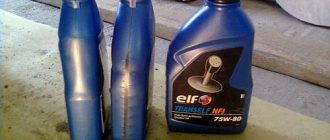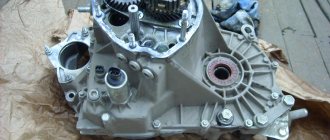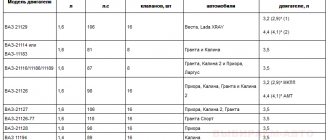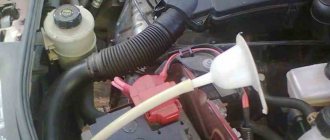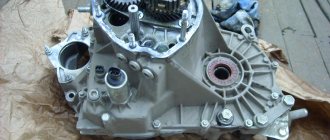Changing the oil in the Lada Largus gearbox is an important procedure on which the service life of the gearbox of a domestic station wagon depends.
From the very moment of its release and the start of sales, the Lada Largus station wagon has established itself as an excellent and unpretentious “workhorse”. But, despite its unpretentiousness, Lada Largus requires timely maintenance. Changing the oil in a Lada Largus box is part of the full maintenance of this car, which should be taken as seriously as changing engine oil.
Oil change interval for Lada Largus gearbox
The Lada Largus station wagon went on sale back in 2012. Initially, the manufacturer did not indicate any information on the period for changing the oil in a manual transmission. Arguing this is that the oil is designed for the entire service life of the car and does not require replacement.
In 2014, the maintenance regulations changed, and AvtoVAZ added an item for changing transmission oil in the Lada Largus manual transmission - after 140,000 km. There is no time frame for replacement, only replacement after a certain mileage.
140 thousand kilometers are not covered by the dealer’s warranty, so replacing the transmission oil in the Lada Largus box is entirely the responsibility of the owner.
Although experienced car owners change the oil in the gearbox much earlier - after 60-70 thousand kilometers or after 48 months. In fact, the replacement costs are not so high that it would be worth saving on this to the detriment of the box.
Adviсe
- Before starting work, travel at least 10-15 km so that the oil inside the gearbox warms up and becomes less viscous.
- If the sealing gasket of the filler plug is not torn and is elastic, it can be reinstalled.
- Pay attention to the processing status. The presence of an emulsion indicates mixing of oil and water. Often such a nuisance is a consequence of a leak in the boot of the inner CV joint of the left drive shaft. Therefore, inspect the boot for tears or loose clamps. Pay attention to the transmission breather, through which, if installed incorrectly, water and dirt enter the manual transmission. Often, after unqualified repairs, craftsmen neglect the correct installation of the breather. 4.For preventive purposes, rinse and blow out the breather with compressed air. As the pressure inside the transmission increases, a completely clogged "breather" valve can push out. If the malfunction is not noticed in time, dust, dirt and moisture will render the new gear oil unusable.
5. We recommend lubricating the engine protection mounting bolts with graphite grease.
Seal
What kind of oil should I fill in the Lada Largus gearbox?
Mechanical gearboxes of Lada Largus are filled with API GL-4 class gear oil with a viscosity of 75W80. At the same time, many Largus owners fill in 75W85 or 75W90 oil if 75W80 oil is not on sale. The gearbox is not very picky about the quality of the working fluid, so it “digests” these oils. However, I recommend, whenever possible, using exactly what the manufacturer recommends.
From the factory, the Lada Largus gearbox is filled with elf TRANSELF NFJ 75W-80 transmission oil, which is officially approved by Renault and AvtoVAZ.
Let's consider other suitable oils for Lada Largus:
- Castrol Syntrans Transaxle 75W-90 is a synthetic oil, the best analogue among competitors. In terms of quality and resistance to temperatures, this oil can be compared with the original. After filling with such oil, the gearbox will engage more smoothly and clearly. Owners also note the absence of a crunch when engaging reverse.
- Motul Gear 300 75 W90 is another synthetic oil that gives the gearbox maximum operating efficiency. The properties of this oil have a positive effect on the smoothness and clarity of gear shifting. Crunching and noise are also eliminated
- Shell Getriebeoil EP 75W90 GL4 is frankly not the most suitable oil for Lada Largus. This lubricant is a clear example of the fact that expensive oil is not always the best. There is no doubt about the quality of Shell products, but this product has incompatible parameters with the Lada Largus gearbox, or is simply not adapted for the Russian climate. Largus owners who have tried this oil often complain about hum, noise, vibration and crunching of the synchronizers.
Changing the oil in manual transmission Lada Largus
The procedure for changing the oil in a Lada Largus manual transmission is not a technically difficult job, so it can be easily done independently in a garage.
This instruction is suitable for all types of gearboxes that were installed on the Lada Largus (Van, Station wagon, Cross). These are Renault JH3 and JR5, as well as AvtoVAZ 21809.
Please note that before replacing the transmission fluid, it is necessary to warm up the gearbox to operating temperature - heated oil drains faster and better than cold oil.
1. We drive the car into the inspection hole and remove the crankcase protection, if it is installed. 2. Take the waste container and unscrew the drain plug with an 8″ square wrench. 3. We unscrew the filler plug (aka the control plug) by hand so that the oil flows faster due to air entering the gearbox.
4. After the oil has stopped dripping from the box, you need to screw the drain plug back into place. Before doing this, install a new drain plug gasket. This is a copper washer, which has the article number 77 03 062 062. It looks like this:
In fact, this is a disposable part that requires replacement after unscrewing the plug. But in fact, these plugs can be used 2-3 times if you do not overtighten the plug.
5. Now we need to pour fresh oil into the box. We will do this through the control hole of the filler plug. You can use a special syringe, and you can use a thin tube and funnel, first bringing it up under the hood. The oil volume in the Lada Largus gearbox is not large - about 3 liters, so you can fill it as convenient.
6. We check the oil using the control plug - when the oil starts to flow out, we immediately stop filling. We screw the control plug into place.
At this point, the oil change in the manual transmission can be considered complete. If you removed the engine and gearbox protection, do not forget to reinstall it.
Causes and signs of oil losing its properties
If the transmission fluid is darkened or black in color, this may indicate that the lubricant has undergone a chemical change as a result of severe contamination with wear products of the gearbox elements (gear shafts and synchronizers) or a violation of the tightness of the gearbox (moisture and dirt entering through the seals of the drives or input shaft ).
- The smell of burnt oil in Lada Largus. May indicate insufficient lubrication levels due to leaks. Under heavy loads on the unit, cooling of the rubbing parts is not adequately ensured.
- If shifting gears is difficult, you may hear some noise or hum at certain speeds or when idling. The lubricating properties of the transmission fluid are partially lost or the level in the gearbox housing is insufficient.
- Increased wear of gearbox elements. Aggressive driving style and incorrect gear shifting.
- Mileage over 60,000 km since previous replacement. It is at this interval that service stations recommend replacing the transmission fluid.
Types of oil
Let's look at each type of oil separately:
- Mineral is the most affordable lubricant for gearboxes. Recommended only for high mileage, and only in extreme cases. It is highly undesirable to use such oil at low temperatures. The fact is that mineral oil is very thick and therefore freezes quickly. In the warm season, there are no special problems with mineral water, but it’s still better to choose a more worthy option for the Lada Largus
- Semi-synthetics are the best option, the golden mean between mineral water and expensive synthetics. This oil is obtained by mixing two oils. In this case, more mineral oil is used than synthetics. This explains the relative cheapness of the product. Semi-synthetic is also recommended for cars with high mileage, but for Lada Largus it can be filled at any mileage. The main thing is that the temperature outside the car is not too low
- Synthetic is the most fluid and expensive oil. This lubricant will never freeze, even in the coldest weather. It can be used both in summer and winter. Perhaps synthetic oil is the best option for modern cars such as Lada Largus.
5 manual transmission (JR5)
Available configurations and prices
If a five-speed manual transmission is enough for comfortable driving around the city or on the highway, then you can safely choose the option with a manual transmission5. This unit is identified by the code JR5 according to the Renault company classification. This transmission is equipped with cars in the “Life” (basic configuration) and “Drive” modifications with front-wheel drive and a 1.6-liter engine. The cost is 1,015,000 rubles. and 1105990 rub. respectively.
Specifications
JR5 has been designed by the company's engineers for a long time and has been successfully used on other Renault, Lada and Nissan models for many years. Therefore, it was decided to use it on the new representative of the model range.
Gear ratios
One of the main characteristics of the transmission is rightfully the gear ratio in each gear. Below are the data for 5 manual transmission.
- 3,727.
- 2,048.
- 1,321.
- 0,971.
- 0,738.
Design
This gearbox was not created from scratch. The basis was taken from an old design marked JH3 and reworked to suit modern needs. The basis remains the same: a two-shaft arrangement using synchronizers in all stages and combining with the main gear and differential into one system.
Among the improvements made by engineers, experts note:
- Installation of a hydraulic clutch, which replaced the use of a cable. By such actions, a softer moment of changing gear stages was achieved.
- Direct activation is now carried out by two flexible cables, and not by a rigid rod, as before. This made it possible to remove vibrations inside the unit.
- The Renault Arcana manual transmission in 5 gears can withstand 200 Nm, while its predecessor only 160. The difference of almost 25% is quite noticeable.
The working cylinder and bearing are combined into one unit and bolted to the crankcase.
Most of the box is made of aluminum and steel alloys. High-quality sealants are used to seal the product. The teeth of the reverse gears are different - they are straight, not oblique, as for all the other five. Different types of secondary shaft bearings are used, namely ball and roller.
Exploitation
Resource
According to Renault company representatives, the service life of the JR5 gearbox without repairs or breakdowns can be 250 thousand kilometers. After this, if not earlier, of course, adventures will begin in the form of repairs or replacement of individual components. To prevent this from happening, you need to keep an eye on the box. The first thing is to change the oil on time, do not overload in cold or very hot seasons, and do not transport cargo more than allowed in the technical specifications. In practice, with a gentle operating mode without major repairs, it turns out to “run back” twice as much
Change of oil
According to the scheduled list of replacement works, a mask is not provided for in the Renault Arcana manual transmission. But service center specialists insist on changing the fluid every 60 thousand mileage. The procedure will not cost the owner very much, but will significantly extend the life of the unit. To change, you need to use branded oil ELF Tranself NFJ 75W80. For a complete replacement, 2.5 liters will be enough.
Consumption
Let us remind you that only front-wheel drive Renault Arcana with a 1.6-liter engine are equipped with a manual transmission5. According to the passport data, the consumption should be 7.1 liters of AI-95 gasoline. In practice, the indicator may be higher or lower depending on various factors.
The Renault Arcana 5-speed manual transmission is not a new development, but an improved unit. Therefore, all serious shortcomings in it have been eliminated long ago. Of those that are relevant
It can still be noted: Frequent and constant oil seal leaks.
Gearbox malfunctions and methods for eliminating them
Any mechanism has a tensile strength, especially if it operates under variable loads. It is necessary to take into account the driver's driving style, which significantly affects the durability of the part. Summarizing the accumulated experience and analysis of breakdowns that occur during the operation of the car, gearbox faults can be grouped into several main groups: noise in the gearbox, difficulty engaging the gear and spontaneous shutdown of the transmission.
Noise and difficulty shifting gears
The main causes of noise in the gearbox include:
- low oil level;
- water entering the system;
- wear of bearings or gears.
To fix the problem, you should add or replace the oil in the gearbox, replace the bearings and gears with new ones.
Difficulty shifting gears can be caused by the following factors:
- faulty gearbox control rod;
- loosening of fastenings;
- deformation of control drive parts;
- wear of synchronization rings;
- incomplete disengagement of the clutch.
The listed faults can easily be eliminated by adjusting the clutch and replacing deformed and worn parts. It also helps to adjust the mechanisms in accordance with the regulations indicated in the car’s operating manual.
Spontaneous transmission shutdown
The reasons for spontaneous shutdown of the gearbox are usually:
- gear wear;
- damage occurs on the rubber supports of the box;
- wear of the synchronizer rings.
These faults can only be corrected by replacing them with new parts. Do-it-yourself transmission repair requires high qualifications and a set of special tools. Only a competent specialist can remove and disassemble this part correctly.
If the gearbox malfunctions, it is better to contact a service station, where they will not only repair the unit, but will also give you a guarantee that you can use in the event of a subsequent gearbox breakdown.



